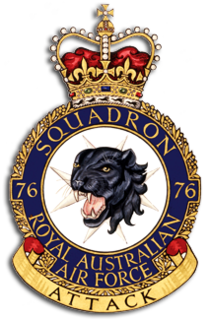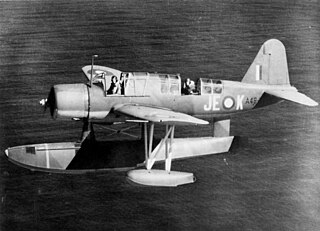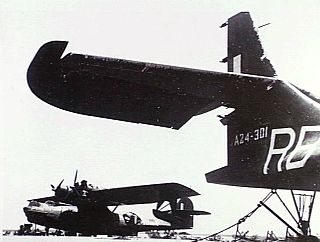
No. 75 Squadron is a Royal Australian Air Force (RAAF) fighter unit based at RAAF Base Tindal in the Northern Territory. The squadron was formed in 1942 and saw extensive action in the South West Pacific theatre of World War II, operating P-40 Kittyhawks. It was disbanded in 1948, but reformed the following year and operated jet aircraft throughout the Cold War. The squadron was based at Malta from 1952 to 1954, flying de Havilland Vampires, and Malaysia from 1968 to 1983, with Dassault Mirage IIIs, before returning to Australia.

No. 77 Squadron is a Royal Australian Air Force (RAAF) squadron headquartered at RAAF Base Williamtown, New South Wales. It is controlled by No. 81 Wing, and equipped with McDonnell Douglas F/A-18 Hornet multi-role fighters. The squadron was formed at RAAF Station Pearce, Western Australia, in March 1942 and saw action in the South West Pacific theatre of World War II, operating Curtis P-40 Kittyhawks. After the war, it re-equipped with North American P-51 Mustangs and deployed to Japan as part of the British Commonwealth Occupation Force. The squadron was about to return to Australia when the Korean War broke out in June 1950, after which it joined United Nations forces supporting South Korea. It converted from Mustangs to Gloster Meteor jets between April and July 1951 and remained in Korea until October 1954, claiming five MiG-15s and over five thousand buildings and vehicles destroyed during the war for the loss of almost sixty aircraft, mainly to ground fire.

No. 76 Squadron is a Royal Australian Air Force (RAAF) flight training squadron. Established in 1942, it operated P-40 Kittyhawk fighter aircraft in the South West Pacific theatre during World War II. Following the end of hostilities it re-equipped with P-51 Mustangs and formed part of Australia's contribution to the occupation of Japan until disbanding in 1948. The squadron was re-formed in 1949 and three years later transferred to Malta, where it operated de Havilland Vampire jet fighters on garrison duty until again disbanding in 1955. It was reactivated in 1960 and operated CAC Sabre and Dassault Mirage III fighters in Australia until 1973. No. 76 Squadron was re-formed in its present incarnation in 1989 and is currently stationed at RAAF Base Williamtown, New South Wales, where it operates Hawk 127 jet training aircraft.

No. 107 Squadron was a Royal Australian Air Force maritime patrol squadron of World War II. It was formed in May 1943 and was equipped with Vought OS2U Kingfisher aircraft. The squadron conducted anti-submarine patrols off the Australian east coast during the last years of the war, but did not encounter any enemy submarines. It was disbanded in October 1945.

No. 42 Squadron was a Royal Australian Air Force (RAAF) mine laying and maritime patrol squadron of World War II. It was formed in June 1944 and conducted patrol and mine-laying operations over the Netherlands East Indies (NEI) from August 1944 until the war ended a year later, as well as operations in the waters off southern China in early 1945. Following the Japanese surrender, the squadron performed transport and reconnaissance flights until it was disbanded in November 1945.

No. 14 Squadron was a Royal Australian Air Force maritime patrol squadron of World War II. It was formed in 1939 and was based in Western Australia throughout the war. While it conducted many patrols over the waters off Western Australia, it did not see combat. The squadron was disbanded in December 1945.

No. 12 Squadron was a Royal Australian Air Force (RAAF) general purpose, bomber and transport squadron. The squadron was formed in 1939 and saw combat in the South West Pacific theatre of World War II. From 1941 to 1943, it mainly conducted maritime patrols off northern Australia. The squadron was based at Merauke in western New Guinea from November 1943 to July 1944, when it was withdrawn from operations. After being re-equipped, it operated as a heavy bomber unit from February 1945 until the end of the war. The squadron continued in this role until it was redesignated No. 1 Squadron RAAF in February 1948. The squadron was reformed in 1973 to operate transport helicopters but was again disbanded in 1989.

No. 67 Squadron was a Royal Australian Air Force (RAAF) maritime patrol squadron of World War II. It was formed in January 1943, conducted patrols off the southern Australian coastline until the end of the war, and was disbanded in November 1945.

No. 20 Squadron is a Royal Australian Air Force (RAAF) support squadron. Coming under the control of No. 96 Wing, it is responsible for the management of the airfield at RAAF Base Woomera, South Australia. The squadron originated as a maritime patrol unit during World War II. Raised in August 1941, it operated PBY Catalina and Short Empire flying boats from bases in New Guinea, Queensland and the Northern Territory, conducting search-and-rescue, mine-laying, anti-submarine and bombing missions against Japanese targets in the Pacific theatre. Following the conclusion of hostilities, the squadron was disbanded in March 1946. It was reactivated as an airfield support squadron in April 2015.

No. 15 Squadron was a Royal Australian Air Force (RAAF) light bomber and maritime patrol squadron of World War II. The squadron was formed in January 1944 and initially flew anti-submarine patrols off the east coast of Australia. From September that year elements of the squadron took part in the New Guinea Campaign, and the main body of the squadron moved to New Guinea in March 1945. Its duties in New Guinea included anti-submarine and anti-barge patrols as well as attacking Japanese positions. No. 15 Squadron was demobilised after the end of the war, and was formally disbanded in March 1946.

No. 100 Squadron was a Royal Australian Air Force (RAAF) bomber and maritime patrol squadron that operated during World War II. Raised in early 1942 from the remnants of a British unit that had been destroyed in Malaya, the squadron flew Bristol Beauforts from bases in Queensland and New Guinea, undertaking torpedo- and level-bombing sorties against Japanese targets in the Pacific theatre. Following the conclusion of hostilities, the squadron was disbanded in August 1946.

No. 93 Squadron was a Royal Australian Air Force fighter squadron that operated during World War II. It was formed in January 1945 and disbanded in August 1946. Due to delays in bringing operational airfields into service, the squadron saw little combat before the end of the war.

No. 78 Wing is a Royal Australian Air Force (RAAF) operational training wing, headquartered at RAAF Base Williamtown, New South Wales. It comprises Nos. 76 and 79 Squadrons, operating the BAE Hawk 127 lead-in fighter, and No. 278 Squadron, a technical training unit. No. 79 Squadron, located at RAAF Base Pearce, Western Australia, is responsible for converting new pilots to fast jets, while No. 76 Squadron at Williamtown conducts introductory fighter courses; both units also fly support missions for the Royal Australian Navy and the Australian Army.

No. 22 Squadron is a Royal Australian Air Force (RAAF) mixed Permanent and Reserve squadron that provides support for the RAAF in the Sydney region. Formed in 1936, the squadron served in Papua New Guinea during the Second World War, and later followed the Pacific War as far as the Philippines. Following the war, the squadron was re-formed in 1948 but was converted to a non-flying support role in mid-1960. It is currently based at RAAF Base Richmond, New South Wales.

No. 457 Squadron was a Royal Australian Air Force (RAAF) fighter squadron of World War II. Equipped with Supermarine Spitfire fighters, it was formed in England during June 1941 under Article XV of the Empire Air Training Scheme. The squadron was transferred to Australia in June 1942 and saw combat in the South West Pacific Area before being disbanded in November 1945.

No. 78 Squadron was a Royal Australian Air Force (RAAF) fighter squadron of World War II. It was formed in July 1943 as part of expansion of the RAAF's fighter force, and was assigned to mobile striking forces for the duration of the war.

No. 80 Squadron was a Royal Australian Air Force (RAAF) fighter squadron that operated during World War II. The squadron was formed in September 1943 and was disbanded in July 1946 after seeing action in the South West Pacific Theatre of the war.

No. 82 Squadron RAAF was a Royal Australian Air Force fighter squadron that operated during World War II and its immediate aftermath. It was formed in June 1943, flying Curtiss P-40 Kittyhawks and, initially, Bell P-39 Airacobras from bases in Queensland and New Guinea. The squadron became operational in September 1944, and undertook ground attack missions against Japanese targets in the Pacific theatre. Following the end of hostilities, No. 82 Squadron was re-equipped with North American P-51 Mustangs and deployed to Japan, where it formed part of the British Commonwealth Occupation Force. It remained there until October 1948, when it was disbanded.

No. 76 Wing was a Royal Australian Air Force (RAAF) wing that operated during World War II. Initially based in Far North Queensland, its headquarters transferred to Darwin, Northern Territory, in September 1944 to take control of three PBY Catalina units: Nos. 20, 42, and 43 Squadrons. The prime task of these squadrons was minelaying in the South West Pacific theatre, and they conducted these operations as far afield as Java, Borneo, the Philippines, and China. As well as minelaying, No. 76 Wing's Catalinas flew bombing, patrol, and transport missions, and dropped millions of propaganda leaflets in the closing months of the war. The wing headquarters disbanded in November 1945.

Western Area Command was one of several geographically based commands raised by the Royal Australian Air Force (RAAF) during World War II. It was formed in January 1941, and controlled RAAF units located in Western Australia. Headquartered in Perth, Western Area Command was responsible for air defence, aerial reconnaissance and protection of the sea lanes within its boundaries. Its aircraft conducted anti-submarine operations throughout the war, and attacked targets in the Dutch East Indies during the Borneo campaign in 1945.



















